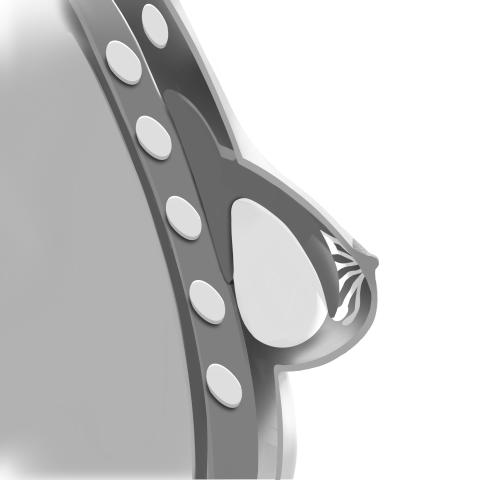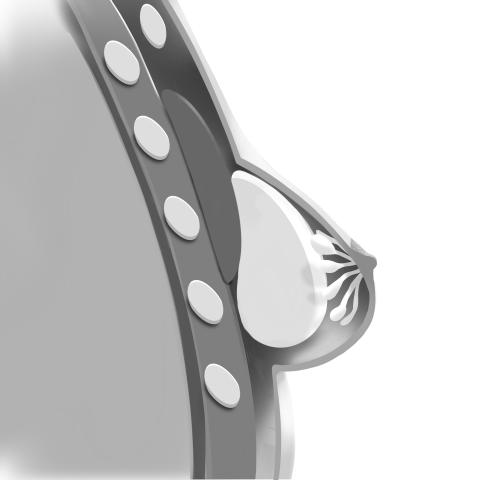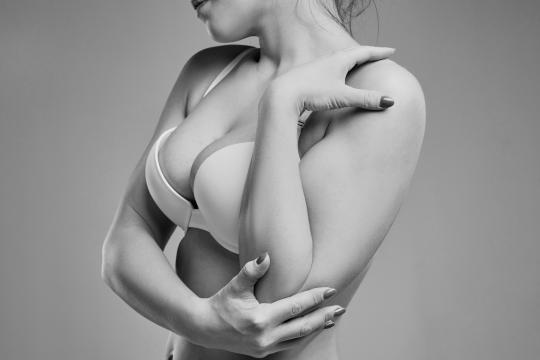How is a breast revision surgery performed?
Breast revision is typically an outpatient procedure. The exact process your surgeon will use for breast implant removal and replacement varies depending on the reason for your revision.
Change in Breast Size
If you decide to change your implant size, your surgeon will likely use your original incision for implant removal and replacement.
- If you want a larger implant, your surgeon will enlarge the breast "pocket" surrounding your implant to accommodate a larger implant.
- If you want smaller implants, your surgeon may reduce the size of the pocket with sutures to properly fit smaller sized implants. Your surgeon may also recommend a breast lift at the same time.
Capsular Contracture (hardening of the capsule and implant)
Your surgeon will likely use your same incision from your original implant procedure to remove the hardened capsule and implant. He or she then inserts a new implant and closes your incisions.
Implant Rippling
When the edges of saline implants are visible, or if you can feel them through your skin, you may desire surgery to remove, reposition, or replace your implants.
- Your surgeon will likely use the same incision to remove or reposition the implants as was used to insert them initially.
- Or your surgeon may replace the implant with a different type of implant, typically placing the new implant into a different breast pocket that either has thicker muscle coverage or uses other tissues to cover the implant edge.
Implant Malposition
If your original surgeon created implant pockets that are too far apart or too close together, you may end up with poorly positioned breasts. A board-certified aesthetic plastic surgeon can correct this issue.
- Your new aesthetic plastic surgeon will likely use the prior incisions to manipulate the scar tissue from the capsule surrounding your implants.
- The surgeon will reconstruct the pocket in the appropriate position using suturing techniques.
- Your surgeon may need to utilize other tissues to reinforce this new implant pocket and may recommend using an acellular dermal matrix product. Known by the acronym “ADM”, Acellular Dermal Matrix eventually gets integrated into the body. It is completely replaced by your own collagen, resulting in a thicker, stronger layer of tissue. It is natural and bioresorbable yet maintains its strength over time. Your surgeon will attach ADM with absorbable sutures to the existing capsule, anchoring it to its new position to add additional support.
Implant Removal
If you are no longer happy with your implants, you can have them removed by an aesthetic plastic surgeon.
- If your implants are large and your skin has stretched, your surgeon may recommend a breast lift with your implant removal, but implant removal alone may suffice.
- Your surgeon will likely use the original implant incision to remove your implants.
- The surgeon often surgically removes the lining around the implant, or "capsule," at the same time to facilitate rapid healing.
- Your surgeon then closes the incision.
Elevation of Nipple and Areola Position
If it is necessary to elevate the position of your nipples and areolas (pigmented skin surrounding the nipples), you will need additional incisions (see breast lift incisions and scars).
- If not much elevation is needed, your surgeon will make incisions around the upper portion of the areola.
- If more lifting and tightening is necessary, your surgeon will make an incision all the way around the areola. He or she may also make an incision extending down from the areola to the crease under the breast.
- For cases where significant excess skin needs to be removed (such as in women who have had massive weight loss), a third incision may be necessary. The third incision will extend horizontally beneath the breast, following the natural curve of the breast crease.
- If your nipples need lifting, your surgeon will adjust them, but the nipples and areolas remain attached to underlying mounds of tissue. This technique usually maintains sensation and the ability to breastfeed.
The goal of your aesthetic plastic surgeon is to help you achieve the most beautiful and natural-looking results with the least amount of scarring and make your surgical experience as easy and comfortable as possible.
Where will the surgeon place my breast implants?
Multiple factors, including your anatomy and your original breast implant placement, will determine how your surgeon inserts and positions your new breast implant. Your surgeon will place the implant in a pocket in one of the below locations. Be sure to ask your surgeon the pros and cons of each option.
Underneath the Pectoral Muscle
The pectoral muscle is between the breast tissue and chest wall. With this placement, the surgeon places the implant underneath the pectoral muscle and on top of the chest wall. This placement may interfere less with mammograms and breast-feeding. However, the implant may move when you flex your chest muscles.

On Top of the Pectoral Muscle
The pectoral muscle is between the breast tissue and chest wall. With this placement, the surgeon places the implant underneath the breast tissue and on top of the pectoral muscle. This placement may interfere with mammograms and breast-feeding. However, the implant should stay in place when you flex your chest muscles.

What type of breast implants are there?
If you aren’t happy with your original implants, there are several other breast implant choices. Your aesthetic plastic surgeon will help you select an option based on your breast size and shape, medical history, and desired outcome.
You can choose between saline implants and silicone implants. Choosing the type of implant typically comes down to personal preference and your surgeon’s opinion. You will also need to select a size and shape.
Saline-Filled Breast Implants
Saline breast implants are filled with sterile saltwater. The surgeon fills the implants during the surgery to allow for minor modifications in the implant size.
Structured Saline-Filled Breast Implants
Structured saline breast implants are filled with sterile saltwater but contain a structure inside so they behave as if they are filled with soft, elastic silicone gel. These implants hold their shape better than traditional saline implants. The FDA and Health Canada approved these implants in 2014, and they have been available since 2015.
Silicone Gel-Filled Breast Implants
Silicone gel breast implants are filled with soft, elastic gel and are available in various shapes and degrees of firmness. All silicone gel breast implants are pre-filled. If you are getting a larger implant, you’ll likely have a longer incision.
Cohesive Gel Silicone Gel-Filled Breast Implants (also known as “gummy bear” or “form-stable” implants)
Cohesive gel silicone breast implants are filled with a cohesive gel, made of crosslinked molecules of silicone, which makes them a bit thicker and firmer than traditional silicone gel implants. They hold their shape better than traditional silicone gel implants too. The FDA approved these implants for use in the United States in 2012. These implants have been available in many areas of the world since 1992.



